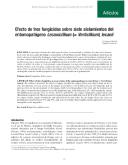| dc.description.abstract | Se investigó el efecto del oxicloruro de cobre, el clorotalonil y el sulfato de cobre en el desarrollo in vitro de siete cepas del hongo Lecanicillium (=Verticillium) lecanii. Todos los productos mostraron un efecto adverso al desarrollo del hongo, el cual varió dependiendo de la cepa y del producto evaluado. El efecto sobre el desarrollo micelial fue de tipo fungistático, y se detectaron diferencias estadísticas (P menor que 0,05) entre las diferentes cepas. Los porcentajes de inhibición fueron de 79,20 por ciento, 68,53 por ciento y 28,39 por ciento, para el oxicloruro de cobre, el sulfato de cobre y el clorotalonil, respectivamente. La cepa más sensible tuvo una inhibición de 90,78 por ciento, 89,52 por ciento, y 36,13 por ciento para el sulfato de cobre, el oxicloruro de cobre y el clorotalonil, respectivamente. El efecto sobre la germinación con la dosis alta fluctuó entre 97 y 99 por ciento y fue irreversible. Al parecer, las cepas catalogadas como de conidios pequeños fueron las más afectadas en su germinación The authors researched the effect of copper oxychloride, copper sulfate and chlorotalonil on the in vitro development of seven strains of the fungus Lecanicillium (=Verticillium) lecanii. All fungicides had an adverse effect on the development of the fungus, which varied depending of the strain and the product used. The effect on mycelia development was of the fungistatic type, with differences (P minor who 0.05) among the strains. The inhibition percentages were of 79.24 percent, 68.53 percent, and 28.39 percent, for copper oxychloride, copper sulfate and chlorotalonil, respectively. The most sensitive strain presented an inhibition rate of 90.78 percent, 89.52 percent and 36.13 percent for copper sulfate, copper oxychloride and chlorotalonil, in that order. For the higher doses, the effect on germination varied between 97 and 99 percent , and was irreversible. Small conidia strains appeared to be more susceptible to the fungicides. | es_ES |


